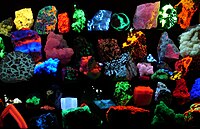
Photo from wikipedia
The common fluorescent conjugated materials present weak or quenching luminescent phenomena in the solid or aggregate state (ACQ), which limits their applications in medicine and biology. In the last two… Click to show full abstract
The common fluorescent conjugated materials present weak or quenching luminescent phenomena in the solid or aggregate state (ACQ), which limits their applications in medicine and biology. In the last two decades, certain materials, named aggregation-induced emission (AIE) fluorescent materials, have exhibited strong luminescent properties in the aggregate state, which can overcome the ACQ phenomenon. Due to their intrinsic properties, the AIE materials have been successfully used in biolabeling, where they can not only detect the species of ions and their concentrations in organisms, but can also monitor the organisms’ physiological activity. In addition, these kinds of materials often present non-biological toxicity. Thus, AIE materials have become some of the most popular biofluorescent probe materials and are attracting more and more attention. This field is still in its early infancy, and several open challenges urgently need to be addressed, such as the materials’ biocompatibility, metabolism, and so on. Designing a high-performance AIE material for biofluorescent probes is still challenging. In this review, based on the molecular design concept, various AIE materials with functional groups in the biofluorescent probes are introduced, including tetrastyrene materials, distilbene anthracene materials, triphenylamine materials, and hexaphenylsilole materials. In addition, according to the molecular system design strategy, the donor–acceptor (D-A) system and hydrogen-bonding AIE materials used as biofluorescent probes are reviewed. Finally, the biofluorescent probe design concept and potential evolution trends are discussed. The final goal is to outline a theoretical scaffold for the design of high-performance AIE biofluorescent probes that can at the same time further the development of the applications of AIE-based biofluorescent probes.
Journal Title: Biosensors
Year Published: 2023
Link to full text (if available)
Share on Social Media: Sign Up to like & get
recommendations!